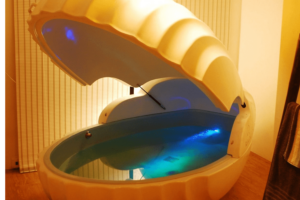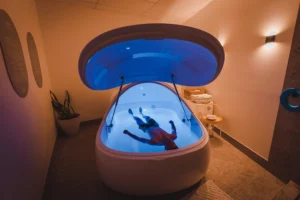Anxiety has become a common struggle in modern life, as many people live under constant stress, pressure, and sensory overload. One therapeutic approach gaining popularity is float tank therapy. But the question arises: how does float tank therapy reduce anxiety? In this article, we explain what float therapy is, explore the science behind float therapy, list its many benefits of float therapy, and show how float session therapy and float session benefits play a role in easing anxiety. We’ll also cover float therapy for depression, the benefits of sensory deprivation float tanks, float tank therapy benefits, and more concluding with an FAQ to clarify key concerns.
What Is Float Therapy?
First, let’s define terms. Float therapy is a therapeutic practice involving floating in a tank or pod that is dark, quiet, and filled with water saturated with Epsom salt (magnesium sulfate). The water is heated to skin temperature, so the boundary between body and water becomes minimal. The tank is designed to isolate external sensory input light, sound, and tactile stimuli which is why it is also known as sensory deprivation float therapy or isolation tank therapy.
The purpose of sensory deprivation tank is to reduce stimuli to the brain, allowing it to shift from external focus to internal rest. With minimal disturbances, your nervous system can slow down, unwind, and recalibrate. This is the essence of float tank therapy benefits: creating a space of profound mental and physical rest.
In practice, a float therapy session or float session therapy typically lasts 60 to 90 minutes. Some centers offer options of 30‑ or 120‑minute sessions, but the standard is one hour or ninety minutes.
The Science Behind Float Therapy & Its Effects
To understand float tank therapy benefits and effects of float therapy, one must look into the physiological and neurological changes that occur during flotation.
Nervous System Shifts & Relaxation Response
When you enter a float or sensory deprivation environment, the sudden removal of light, sound, and touch disrupts the constant stream of sensory input to your brain. Without that input, your brain’s default attention shifts inward, prompting activation of the parasympathetic branch of the autonomic nervous system (the “rest and digest” response) and reducing sympathetic overdrive (the “fight or flight” state). This shift is one of the key float session benefits that directly helps mitigate anxiety.
The effects of float therapy include reduced heart rate, lowered blood pressure, muscle relaxation, and decreased physiological arousal. These changes foster a calmer nervous system and thus alleviate anxious tension.
Hormonal & Biochemical Regulation
Chronic anxiety often involves elevated stress hormones like cortisol and adrenaline. During a float therapy session, cortisol levels can drop or become more regulated because the brain is not constantly triggered by external stressors. Stabilizing these hormones is one of the health benefits of float therapy that supports mental calm. Over time, repeated float session therapy may train your endocrine system toward a less reactive baseline.
Brainwave Patterns & Meditative States
Floating in a quiet, stimulus-free environment encourages shifts in brainwave patterns. Many practitioners report transitions from high-beta (overthinking, active) toward alpha and theta states, similar to deep meditation or early sleep. This is part of the science behind float therapy: in the absence of distractions, the mind can calm and enter productive, restorative states. These shifts help reduce racing thought and anxiety.
Enhanced Interoception & Emotional Processing
A curious but important effect of float therapy is increased interoceptive awareness of internal bodily signals, such as heartbeat, breathing, and gut sensations. In the float environment, you are forced to turn attention inward; in doing so, many users discover suppressed or ignored emotional or bodily states. This deeper access helps with processing anxiety, regulating emotions, and building resilience. That is one of the benefits of sensory deprivation float tanks: encouraging inner awareness.
Immediate & Cumulative Effects
Many people report immediate calm, serenity, and reduced tension after a single float therapy session. These are part of the float session benefits. Over time, as sessions are repeated, the resting baseline of mood, stress sensitivity, and emotional regulation may improve. That is one of the core float tank therapy benefits: cumulative gains in mental health.
In some cases, float therapy for depression also shows beneficial outcomes, because mood systems and anxiety systems are intertwined. By reducing stress and improving emotional balance, floating can lift depressive symptoms in many users.
Step‑by‑Step: How Float Tank Therapy Reduces Anxiety
Here’s a breakdown of how float tank therapy reduces anxiety in practice:
- Sensory Isolation
You enter the tank, lights go off (or are minimal), sound is blocked, and skin sensation is reduced. This is the core concept of sensory deprivation float therapy. - Relaxation & Nervous System Downshift
With diminished external triggers, the parasympathetic system engages, calming heart rate, blood pressure, and breathing. This is one of the most immediate float session benefits. - Hormonal Regulation
As stress input drops, the brain moderates cortisol, adrenaline, and other stress mediators. This contributes to long-term health benefits of float therapy. - Inward Attention & Emotional Processing
Without external distractions, your mind and body turn inward. You may become more aware of thoughts, emotions, or bodily tensions, enabling you to address or release them. This is part of the effects of float therapy. - Brainwave & Mental Quiet
The mind has space to move from high‑frequency thought toward alpha or theta states, where reflection, creativity, and calm emerge. These meditative states support reduction of anxiety. - Positive Feedback & Habit Formation
Experiencing relief reinforces returning to float therapy. Over time, repeated float session therapy strengthens the body-mind’s capacity for calm. - Resilience & Baseline Reset
With repeated sessions, your stress system may recalibrate. You become less reactive to everyday triggers, experiencing fewer anxiety spikes. This long-term change is among the greatest float tank therapy benefits.
Other Benefits of Float Therapy Beyond Anxiety
While anxiety reduction may be your main interest, benefits of float therapy extend into many domains of health and wellness.
- Improved Sleep: Many users report falling asleep more easily and sleeping more deeply after floats.
- Pain Relief & Muscle Recovery: The weightless environment relieves joint stress and helps muscles relax, reducing chronic pain and soreness.
- Mood Enhancement & Depression Support: Because floating alleviates stress and enhances emotional balance, many people experience reduced depressive symptoms (float therapy for depression).
- Increased Focus & Creativity: After floating, many individuals feel mental clarity, better concentration, and creative insights.
- Physical Recovery & Performance: Athletes sometimes use floats to accelerate recovery, reduce inflammation, and refresh the nervous system.
- Reduced Blood Pressure & Cardiovascular Relaxation: The calming environment often leads to lower blood pressure and more relaxed vascular tone.
- Better Overall Stress Management: Over time, floating can support resilience to daily stressors.
- Balance of Mind and Body: Floating can help reconnect mental and physical awareness.
These all add to the health benefits of float therapy and show why many people integrate floating into wellness routines.
What Happens During a Float Session?
Understanding the workflow of a float therapy session (or float session therapy) helps set expectations.
- Preparation & Orientation
The staff briefs you, offers instructions, earplugs, and possibly a shower to remove oils or lotions. - Entry & Adjustment
You enter the isolation tank therapy unit or pod, lie back, and settle into the buoyant medium. The water is buoyant due to Epsom salt. - Sensory Deprivation Phase
Lights go off (or dim), and the environment becomes quiet and dark. You float in stillness, with minimal tactile sensation. - Core Float Time (60–90 Minutes)
During this period, you remain undisturbed. Emptiness gives your mind space. You may drift in and out of thought, dream, or meditative states. - Ending & Reorientation
Lights or ambient cues return, and you exit the tank slowly. After a rinse or shower, you rest momentarily to acclimate. - Post‑Float Experience
Many people feel calm, spacious, light, and emotionally balanced. You may notice float session benefits in clarity, reduced body tension, and mood uplift.
The float deprivation tank benefits are strongest when you can surrender to the experience without interruption or worry.
How Often Should You Float for Best Results?
To maximize float tank therapy benefits, consistency matters. While some people feel benefit after a single session, long-term gains are more likely with repetition.
- Many practitioners recommend starting with one float per week for the first month or two.
- After initial progress, you may shift to biweekly or monthly maintenance sessions.
- Some committed users float twice a week during high-stress periods.
The cumulative impact of repeated float session benefits helps the nervous system adopt a calmer baseline over time.
Limitations, Risks & Precautions
While float therapy for relaxation and anxiety is promising, it has boundaries and caveats.
- Not a Replacement for Medical or Psychological Treatment: Float therapy complements but does not replace therapy, medications, or clinical care.
- Claustrophobia & Panic Risk: Some individuals feel trapped or uneasy in enclosed, dark spaces.
- Skin or Health Concerns: People with open wounds, skin disorders, epilepsy, or uncontrolled medical issues should consult a doctor before floating.
- Quality of Facility: Poorly maintained tanks or hygiene may pose minor risks.
- Initial Discomfort: Beginners may feel disoriented or face intrusive thoughts during early floats.
- Expectations: Floating is not a guaranteed “cure”; individual responses vary.
When approached with care, the benefits of float therapy often outweigh risks for many users.
Why Float Tank Therapy Is Especially Powerful for Anxiety
To summarize why float tank therapy reduces anxiety more effectively than many other techniques:
- Anxiety thrives on hyperstimulation, constant reactivity, and mental noise. Float therapy strips those away.
- It addresses both mind and body simultaneously calming physical tension while quieting mental chatter.
- The immersive, uninterrupted environment accelerates meditative states, bypassing the struggle many face in conventional meditation.
- Repetition reinforces the calmer state, gradually altering stress reactivity and resilience.
- Because anxiety and depression overlap, the calming, mood‑enhancing benefits of floating also assist in lifting depressive tendencies (float therapy for depression).
In short, floatation tanks (or flotation tanks) provide a uniquely potent environment for stress relief, emotional regulation, and mental reset.
FAQ (Frequently Asked Questions)
Q1. What exactly are the benefits of float therapy?
A: The benefits of float therapy include anxiety relief, stress reduction, enhanced mood, better sleep, muscle relaxation, pain reduction, improved focus, and support for depression.
Q2. What is float therapy?
A: Float therapy is a practice where a person floats in a sensory-deprived tank or pod, isolated from light, sound, and tactile stimulus, to allow deep rest and internal focus.
Q3. What are the float session benefits I might notice?
A: You may notice immediate calm, lower tension, clearer thinking, slower breathing, improved mood, and deeper sleep after a float session.
Q4. How many times should I try float session therapy to see results?
A: Many people start with weekly sessions over several weeks to notice sustained anxiety reduction and cumulative health benefits of float therapy.
Q5. Is float tank therapy beneficial for depression as well as anxiety?
A: Yes — many users report that float therapy for depression improves mood, reduces negative thinking, and supports emotional stability.
Q6. What are the benefits of sensory deprivation float tanks specifically?
A: Sensory deprivation float tanks amplify isolation from stimulus, strengthening the inward focus, nervous system calm, and mental clarity that are key to the therapy’s benefits.





